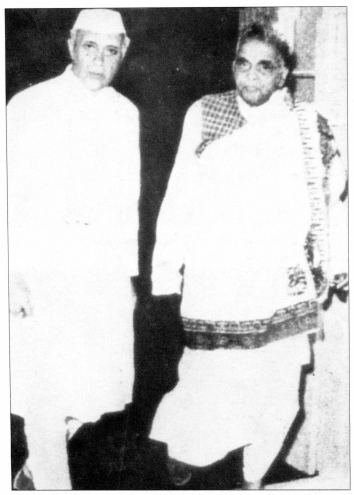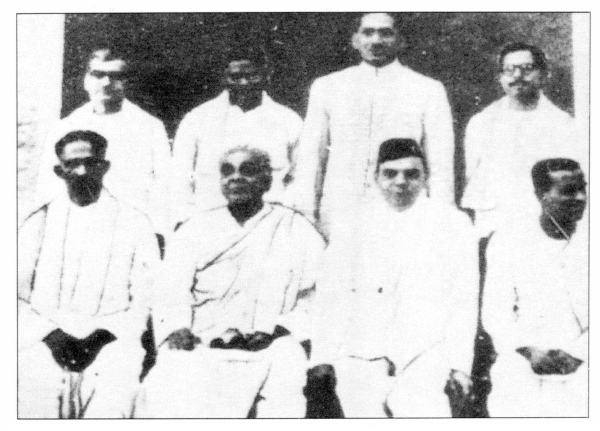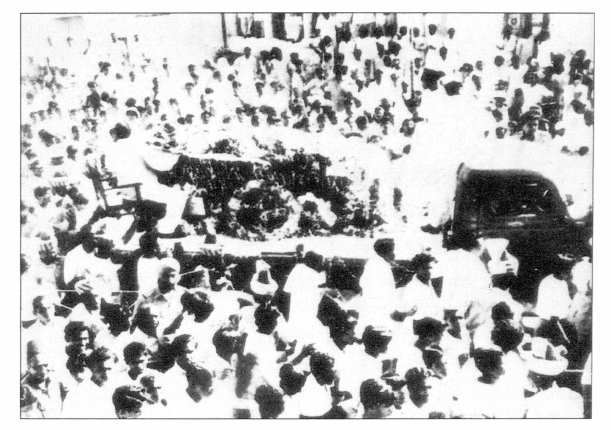(Kuradi Chandrasekhara Kalkura)
Not many knew ‘The Lion of Andhra’ (Andhra Kesari ) Tanguturi Prakasam Pantulu was the son of a putakullamma. Putakullama was the one who used to run a mess (boarding house) which was the forerunner of the modern hotel in India.
Born on 23 August 1872, to Gopalakrishnaiah and Subbamma, in Kanaparthy, a village near Ongole, Prakasam was brought up by his widowed mother, who was running Putakulla place (hotel).
Spending his childhood in Ongole, he migrated to Rajahmundry where he became a disciple of a teacher, Immaneni Hanumantharao Naidu.
With the help and under the influence of Naidu, Prakasam became not only a pleader and an important person in the town, Municipal Chairman. Having earned a reputation and money, he traveled to England to become a Barrister and set up practice in the High Court of Madras.

Prakasam as Madras chief minister
Plunging into the national movement, from 1921 onwards he led all the movements in Andhra Desa, Telugu speaking part of the composite Madras state. He was elected the general secretary of the Congress Party in December 1921 at the Ahmedabad session.
Today is the 150th birth anniversary of Pakasam panthulu
Whenever there was unrest or strife such as a riot, he tried to be there so as to comfort people. He visited Punjab during Akali Satyagraha and the Hindu-Muslim riots in Multan. He toured Kerala during the Moplah rebellion despite a ban on visitors from outside the area and had his property at Ooty attached by the government as a consequence.
తెలుగువారి తెగువకు నిలువెత్తు నిదర్శనం ఆంధ్రకేసరి టంగుటూరి ప్రకాశం పంతులు. ప్రముఖ స్వాతంత్ర్య సమరయోధులు, ఆంధ్రరాష్ట్ర తొలి ముఖ్యమంత్రి ఆంధ్రకేసరి ప్రకాశం పంతులు గారి 150వ జయంతి సందర్భంగా వారికి ఘన నివాళి.
— YS Jagan Mohan Reddy (@ysjagan) August 23, 2021
In 1922, during the Non-cooperation Movement, he organized a demonstration by 30,000 Congress volunteers at Guntur. In 1926, he was elected to the Central Legislative Assembly on a Congress Party ticket.

In 1946, after the Congress’ victory in elections in Madras Presidency Prakasam became the chief minister on 30 April 1946, as he and Kamaraj, a Tamil leader, were against Rajaji — the choice of leaders such as Gandhi and Nehru — becoming the chief minister.
However, the government lasted for only 11 months, as it was felt that Prakasam was not accommodating enough to various varying interests. As reported by Times, during his tenure as premier, Prakasam publicly declared his intention to scrap all textile industries in the province and replace them with khadi manufacturing and weaving units.
He not only gave up the lucrative practice, but also his wealth. He used to say “as a barrister, I earned a lot. People gave me money and I gave it to the nation”. His role in “Simon Go Back” agitation earned him the title “Andhra Kesari”.
Prakasam chooses Kurnool as capital
Though 1953, Prakasam was a non-congressman, the Indian National Congress, led by Pandit Jawaharlal Nehru, the Prime Minister of India, invited him to be the first Chief Minister of the first Linguistic state of Independent India, AndhraState.
There was a hot contest on the location of the capital city. Chief Minister-designate, Prakasam was given the option by the legislators to choose the location. Declining the claims of many leaders for Tirupati, Vijayawada, Guntur, Kadapa and Vishakapatnam and to the utter surprise of one and all his choice was Kurnool.
On lack of facilities and infrastructure at Kurnool, he replied point by point to all the critics. One sample of his point-blank reply; “My assembly will hold its sittings in the maidanam (open place). My Secretariat will function from the tents. My ministers and secretaries will function from thatched huts”.
Though the Assembly was not held in the maiden, the secretariat did really function from the tents, called A, B, and C camps. Houses in these camps and the secretariat buildings were constructed later.
The Andhra state was inaugurated on Oct. 1, 1953, and was capital till the formation of Andhra Pradesh on Nov.1, 1956. For having selected Kurnool as the Capital for the new state an irate mob of Vijayawada demolished his statue. His cool and composure were extraordinary, “I have not asked anybody to install my statue. Those who erected it, have the right to desecrate it.”
The Krishna barrage at Vijayawada was washed away in 1951 floods. In spite of heavy odds, he rebuilt the same, in 1954. He was received with open arms and a new statue was unveiled in the same place before he reached Vijayawada. The great full disciple of Prakasam, Neelam Sanjeeva Reddy, the first Chief Minister of Andhra Pradesh, later named it after him, “Prakasam Barrage”. One sitting of the Assembly was held on the Andhra University campus, Waltair (Visakhapatnam).
Achievements
He had already had SAHASRA CHANDRA DARSHANA, past eighty years. During the thirteen months of his rule as the chief minister, the government of Andhra reconstructed the Krishna Barrage (Prakasam Barrage), instituted the Sri Venkateswara University, Tirupati, established the Andhra High Court at Guntur, got clearance from the Planning Commission and the Central Government for the Nandikonda (Nagarjuna Sagar) Project, and constructed the secretariat building at Kurnool, which now houses the Kurnool Medical College.
After 50years it is still in good stead and the Kurnool Medical College, in 2007-08 celebrated the Golden Jubilee and the President of India A.P.J.Abdul Kalam was the chief guest. It would have been gracious for the government of AP to acknowledge the services Prakasam and named the College after the Andhra Kesari
On assuming office, he was convinced that the joy of the formation of Andhra State, should be shared by one and all and set free all the prisoners in all the jails in the new State.
It should not be forgotten that it was Prakasam who laid the foundations on sound footings for the larger state Andhra Pradesh to be formed in 1956.
The temporary developments made are the boons for Kurnool. All these achievements were in an age in which the transportation and communication in the country were in a primitive stage and against heavy odds.
Late Vavilala Gopalakrishnaiah once opined that no other Government in Andhra Pradesh had matched the achievements of the short-lived Prakasam’s.
Prakasam was deceived and backstabbed by his own disciples and followers. Through a no-confidence motion, he was deposed as Chief Minister of Andhra State.

Prakasam was sarcastically questioned by the Pressmen “Panthulugaru, your rigidity caused the defeat of your Ministry. You have no shelter. Where do you go from here”?
Walking down the wooden steps of the Assembly Hall of the duplex building (present District Court building in Kurnool), an unruffled (Sthithapragna) Prakasam roared “When the streets, nagaras and the colonies are named after me, why should I have a home of my own? Remember, that a lion does never eat grass”. After putting in his papers, he refused the services of the government car and got into a cycle rickshaw.
A legend in his lifetime itself, “Prakasam was Andhra Desa and Andhra Desa was Prakasam”. A lion looks back its steps, Simhavalokanam. Prakasam always remembered the days of penury. He was not shy of wearing old and torn shirts and covers it up with the Coat or a Shawl.
Full of glory and honors, Andhra Kesari, Tanguturi Prakasam Pantulu died, on May 20, 1957, at Hyderabad. A crowd, never seen before in the city of Hyderabad, or anywhere in Andhra Pradesh, bid him a tearful farewell forever. But the legacy of Prakasam will last forever.

Chandrasekhar! Your everlasting spirit of thrusting momentum into apathetic minds like the one I have is really adorable. you just filled my fading memories with fresh ink by raising the story of our one and only honest chief minister Tanguturu Prakasam pantulu. Thanks
Nice narration